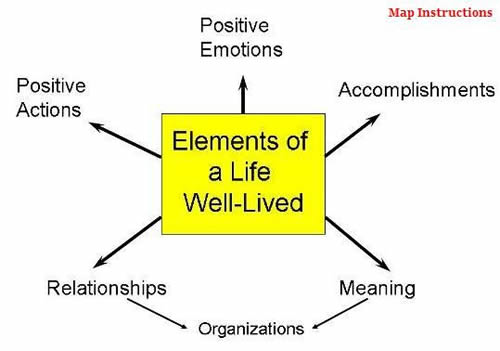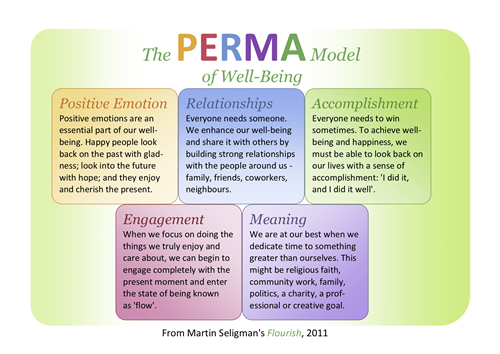Lesson 9: Flow, Flourishing, and PERMA
Attention


Learning Outcomes
Upon completion of this lesson's material, students will be able to:
- Demonstrate an understanding of practical interventions utilized in Positive Psychology and how to implement them in one's own and/or other's lives.
- Students will become aware of their own sense of self, strengths, skills, presence and influence on one self and one another.
- Students will understand that, if intentional about increasing their positive interactions, a positive feeling will correlate.
- Students will exhibit skills in critical and analytical thinking.
- Students will develop dispositions to form opinions and modify positions based on evidence.
- Develop self-efficacy and grounded optimism.
- Evaluate and recognize the relationship between the mind and the body in order to enhance physical and mental health.
- Enhance positive emotions and navigate painful ones.
Teaching
Click HERE to visit the Success Integrated website and view the video from Martin Seligman on Flourishing
Rules from Positivity by Barbara Fredrickson
- Express Gratitude
- Cultivate Optimism
- Avoid Over Thinking & Social Comparison
- Perform Random Acts of Kindness
- Nurture Social Relationships
- Develop Strategies for Coping
- Learn Forgiveness
- Increase Flow Experiences
- Savor Life's Joys
- Make a Commitment
- Practice Religion & Spirituality
- Practice Meditation
- Engage in Physical Activity
- Act like a Happy Person
Tools from "The How of Happiness"s by Sonja Lyubormirsky
Tool 1: Be Open
Tool 2: Create High Quality Connections
Tool 3: Cultivate Kindness
Tool 4: Develop Distractions
Tool 5: Dispute Negative Thinking
Tool 6: Find Nature Nearby
Tool 7: Learn and Apply Your Strengths
Tool 8: Meditate Mindfully
Tool 9: Meditate on Loving-Kindness
Tool 10: Ritualize Gratitude
Tool 11: Savor Positivity
Tool 12: Visualize Your Future
Taken from Change Your Brain, Change Your Life by Daniel G. Amen, MD – adapted by Rebecca A. Martin, LCPC
- STOP/LIMIT Automatic Negative Thinking Tendencies
- Use Guided Imagery; Try Diaphragmatic BREATHING; Try Meditation or Yoga
- Don't think that other people are judging you- We are all too busy judging ourselves.
"We get to thinking we're the center of the universe and everyone's watching, so we hold ourselves to really high standards for fear of judgment," Dr. Phil explains. His dad used to say, "You wouldn't worry so much about what people thought of you if you knew how seldom they did."
- Learn How to Deal With Conflict
Don't give in to the anger of others just because it makes you uncomfortable Don't allow the opinions of others to control how you feel about yourself Say what you mean and stick up for what you believe is right Maintain self-control Be kind, if possible, but be sure to be genuine in your stance
- Develop and Maintain Clear Focus – What is your goal?
What do you want from an interaction? What need is trying to be met?
- FOCUS on WHAT YOU LIKE a Lot More than What You DON'T LIKE
- Have MEANING and EXCITEMENT in Your Life
- Get ORGANIZED; Get HELP when you need it
- Don't Be Another Person's STIMULANT or TRIGGER -- Don't yell. The more his/her voice goes up, the more your voice should go down.
If you feel the situation starting to get out of control, take a break. Use Humor to defuse the situation (not sarcasm or angry humor). Be a good listener.
- Try MOZART, BEETHOVEN, or INSTRUMENTAL MUSIC for FOCUS
- Notice when you are STUCK, DISTRACT YOURSELF, and come back to the problem later
Sing a favorite song. Listen to positive/uplifting music. Take a walk. Do a chore. Play with a pet.
- THINK THROUGH Answers BEFORE Automatically Saying Something
- WRITE OUT OPTIONS and Solutions When You Feel Stuck:
* Make Pros and Cons lists, SODA Lists (Situation, Options, Disadvantages, Advantages) - Seek the COUNSEL OF OTHERS When You Feel Stuck
Albert Einstein said: "Problems cannot be solved with the same mindset that created them."
- MEMORIZE AND RECITE A QUOTE When Bothered by REPETITIVE Thoughts – Think Seinfeld's: SERENITY NOW!
- DON'T TRY TO CONVINCE Someone Who Is Stuck; Take a Break & Come Back Later
- Try Making PARADOXICAL REQUESTS (Reverse Psychology)
If you want a hug, it is often best to say something like "You probably wouldn't want to give me a hug?" If you want a child to comply with a request without giving you a problem, say, "You probably wouldn't be able to do this without getting upset, would you?"
- NUTRITION (MIND/Body) and EXERCISE (BODY/Mind)
The Flow Experience in Education
Click HERE to view this directly on YouTube
Assessment
Lesson 9 Assignment
Review all the material in the lesson, and others if it is helpful. View the videos IN THE LESSONS and attend to the tools and rules listed in lesson 9.
Write a 1000 word essay: After reading the text, participating in the discussions and completing the assignments: Write a 1000 word essay that compares and contrasts the tools listed in the lesson, and describe how you will implement at least 10 of these tools into your daily life, and why. This Essay can be in an informal and journal style. Use the concepts of PERMA as a guideline, how will you incorporate these tools in order to improve your own PERMA.
- Positive emotions - how to feel good
- Engagement - how to be fully absorbed in activities (flow state)
- Relationships - how to be authentically connected to others
- Meaning - how to lead a purposeful existence
- Accomplishment - how to achieve
Lesson 9 Discussion
After watching the Martin Seligman video (linked at beginning of Lesson 9) discuss whether we can, as individuals and/or communities, build well-being (using PERMA and aspects of the BioPsychoSocial Model) – integrate the science of p (positive emotion) and the science of e (engagement), look at relationships and other aspects of meaning and accomplishment as it applies to you. Can we be happier? And, how? Please discuss in as much depth as you can, and don't forget to respond to another classmates post!